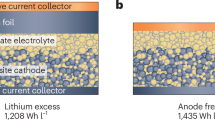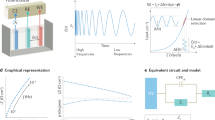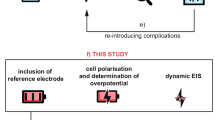Abstract
Although lithium-ion batteries are ubiquitous in portable electronics, increased charge rate and discharge power are required for more demanding applications such as electric vehicles. The high-rate exchange of lithium ions required for more power and faster charging generates significant stresses and strains in the electrodes that ultimately lead to performance degradation. To date, electrochemically induced stresses and strains in battery electrodes have been studied only individually. Here, a new technique is developed to probe the chemomechanical response of electrodes by calculating the electrochemical stiffness via coordinated in situ stress and strain measurements. We show that dramatic changes in electrochemical stiffness occur due to the formation of different graphite–lithium intercalation compounds during cycling. Our analysis reveals that stress scales proportionally with the lithiation/delithiation rate and strain scales proportionally with capacity (and inversely with rate). Electrochemical stiffness measurements provide new insights into the origin of rate-dependent chemomechanical degradation and the evaluation of advanced battery electrodes.
This is a preview of subscription content, access via your institution
Access options
Subscribe to this journal
Receive 12 print issues and online access
$259.00 per year
only $21.58 per issue
Buy this article
- Purchase on SpringerLink
- Instant access to full article PDF
Prices may be subject to local taxes which are calculated during checkout





Similar content being viewed by others
References
Etacheri, V., Marom, R., Elazari, R., Salitra, G. & Aurbach, D. Challenges in the development of advanced Li-ion batteries: a review. Energy Environ. Sci. 4, 3243–3262 (2011).
Zaghib, K., Mauger, A., Groult, H., Goodenough, J. B. & Julien, C. M. Advanced electrodes for high power Li-ion batteries. Materials 6, 1028–1049 (2013).
Tavassol, H., Cason, M. W., Nuzzo, R. G. & Gewirth, A. A. Influence of oxides on the stress evolution and reversibility during SnOx conversion and Li-Sn alloying reactions. Adv. Energy Mater. 5, 1400317 (2015).
Tavassol, H. et al. Surface coverage and SEI induced electrochemical surface stress changes during Li deposition in a model system for Li-ion battery anodes. J. Electrochem. Soc. 160, A888–A896 (2013).
Sethuraman, V. A., Chon, M. J., Shimshak, M., Srinivasan, V. & Guduru, P. R. In situ measurements of stress evolution in silicon thin films during electrochemical lithiation and delithiation. J. Power Sources 195, 5062–5066 (2010).
Mukhopadhyay, A. et al. Engineering of graphene layer orientation to attain high rate capability and anisotropic properties in Li-ion battery electrodes. Adv. Funct. Mater. 23, 2397–2404 (2013).
Chon, M. J., Sethuraman, V. A., McCormick, A., Srinivasan, V. & Guduru, P. R. Real-time measurement of stress and damage evolution during initial lithiation of crystalline silicon. Phys. Rev. Lett. 107, 045503 (2011).
Mukhopadhyay, A., Tokranov, A., Xiao, X. & Sheldon, B. W. Stress development due to surface processes in graphite electrodes for Li-ion batteries: a first report. Electrochim. Acta 66, 28–37 (2012).
Haiss, W. Surface stress of clean and adsorbate-covered solids. Rep. Prog. Phys. 64, 591–648 (2001).
Sethuraman, V. A., Van Winkle, N., Abraham, D. P., Bower, A. F. & Guduru, P. R. Real-time stress measurements in lithium-ion battery negative-electrodes. J. Power Sources 206, 334–342 (2012).
Mukhopadhyay, A., Tokranov, A., Sena, K., Xiao, X. & Sheldon, B. W. Thin film graphite electrodes with low stress generation during Li-intercalation. Carbon 49, 2742–2749 (2011).
Eastwood, D. S. et al. Lithiation-induced dilation mapping in a lithium-ion battery electrode by 3D X-ray microscopy and digital volume correlation. Adv. Energy Mater. 4, 1300506 (2014).
Ebner, M., Marone, F., Stampanoni, M. & Wood, V. Visualization and quantification of electrochemical and mechanical degradation in Li ion batteries. Science 342, 716–720 (2013).
Huang, J. Y. et al. In situ observation of the electrochemical lithiation of a single SnO2 nanowire electrode. Science 330, 1515–1520 (2010).
Liu, X. H. et al. Anisotropic swelling and fracture of silicon nanowires during lithiation. Nano Lett. 11, 3312–3318 (2011).
Jesse, S. et al. Direct mapping of ionic transport in a Si anode on the nanoscale: time domain electrochemical strain spectroscopy study. ACS Nano 5, 9682–9695 (2011).
Balke, N. et al. Nanoscale mapping of ion diffusion in a lithium-ion battery cathode. Nature Nanotech. 5, 749–754 (2010).
Lewis, R. B., Timmons, A., Mar, R. E. & Dahn, J. R. In situ AFM measurements of the expansion and contraction of amorphous Sn-Co-C films reacting with lithium. J. Electrochem. Soc. 154, A213–A216 (2007).
Jones, E. M. C., Silberstein, M. N., White, S. R. & Sottos, N. R. In situ measurements of strains in composite battery electrodes during electrochemical cycling. Exp. Mech. 54, 971–985 (2014).
Qi, Y. & Harris, S. J. In situ observation of strains during lithiation of a graphite electrode. J. Electrochem. Soc. 157, A741–A747 (2010).
Ning, G., Haran, B. & Popov, B. N. Capacity fade study of lithium-ion batteries cycled at high discharge rates. J. Power Sources 117, 160–169 (2003).
Buqa, H., Goers, D., Holzapfel, M., Spahr, M. E. & Novák, P. High rate capability of graphite negative electrodes for lithium-ion batteries. J. Electrochem. Soc. 152, A474–A481 (2005).
Li, J., Murphy, E., Winnick, J. & Kohl, P. A. The effects of pulse charging on cycling characteristics of commercial lithium-ion batteries. J. Power Sources 102, 302–309 (2001).
Li, Y. et al. Current-induced transition from particle-by-particle to concurrent intercalation in phase-separating battery electrodes. Nature Mater. 13, 1149–1156 (2014).
Mukhopadhyay, A. & Sheldon, B. W. Deformation and stress in electrode materials for Li-ion batteries. Prog. Mater. Sci. 63, 58–116 (2014).
Sethuraman, V. A., Hardwick, L. J., Srinivasan, V. & Kostecki, R. Surface structural disordering in graphite upon lithium intercalation/deintercalation. J. Power Sources 195, 3655–3660 (2010).
Hardwick, L. J., Buqa, H. & Novák, P. Graphite surface disorder detection using in situ Raman microscopy. Solid State Ion. 177, 2801–2806 (2006).
Barsoukov, E., Kim, J. H., Kim, J. H., Yoon, C. O. & Lee, H. Kinetics of lithium intercalation into carbon anodes: in situ impedance investigation of thickness and potential dependence. Solid State Ion. 116, 249–261 (1999).
Funabiki, A. et al. Impedance study on the electrochemical lithium intercalation into natural graphite powder. J. Electrochem. Soc. 145, 172–178 (1998).
Levi, M. D., Markevich, E. & Aurbach, D. The effect of slow interfacial kinetics on the chronoamperometric response of composite lithiated graphite electrodes and on the calculation of the chemical diffusion coefficient of Li ions in graphite. J. Phys. Chem. B 109, 7420–7427 (2005).
Verma, P., Maire, P. & Novák, P. A review of the features and analyses of the solid electrolyte interphase in Li-ion batteries. Electrochim. Acta 55, 6332–6341 (2010).
Xu, K. Electrolytes and interphases in Li-ion batteries and beyond. Chem. Rev. 114, 11503–11618 (2014).
Tavassol, H., Buthker, J. W., Ferguson, G. A., Curtiss, L. A. & Gewirth, A. A. Solvent oligomerization during SEI formation on model systems for Li-ion battery anodes. J. Electrochem. Soc. 159, A730–A738 (2012).
Dahn, J. R. Phase diagram of LixC6. Phys. Rev. B 44, 9170–9177 (1991).
Aurbach, D., Levi, M. D., Levi, E. & Schechter, A. Failure and stabilization mechanisms of graphite electrodes. J. Phys. Chem. B 101, 2195–2206 (1997).
Aurbach, D., Markovsky, B., Weissman, I., Levi, E. & Ein-Eli, Y. On the correlation between surface chemistry and performance of graphite negative electrodes for Li ion batteries. Electrochim. Acta 45, 67–86 (1999).
Aurbach, D. et al. Common electroanalytical behavior of Li intercalation processes into graphite and transition metal oxides. J. Electrochem. Soc. 145, 3024–3034 (1998).
Dresselhaus, M. S. & Dresselhaus, G. Intercalation compounds of graphite. Adv. Phys. 30, 139–326 (1981).
Stevens, D. A. & Dahn, J. R. The mechanisms of lithium and sodium insertion in carbon materials. J. Electrochem. Soc. 148, A803–A811 (2001).
Takami, N., Satoh, A., Hara, M. & Ohsaki, T. Structural and kinetic characterization of lithium intercalation into carbon anodes for secondary lithium batteries. J. Electrochem. Soc. 142, 371–379 (1995).
Haiss, W. Surface stress of clean and adsorbate-covered solids. Rep. Prog. Phys. 64, 591–644 (2001).
Haiss, W., Nichols, R. J., Sass, J. K. & Charle, K. P. Linear correlation between surface stress and surface charge in anion adsorption on Au(111). J. Electroanalytical Chem. 452, 199–202 (1998).
Drozdov, A. D. A model for the mechanical response of electrode particles induced by lithium diffusion in Li-ion batteries. Acta Mech. 225, 2987–3005 (2014).
Goodenough, J. B. & Park, K.-S. The Li-ion rechargeable battery: a perspective. J. Am. Chem. Soc. 135, 1167–1176 (2013).
Van der Ven, A., Bhattacharya, J. & Belak, A. A. Understanding Li diffusion in Li-intercalation compounds. Acc. Chem. Res. 46, 1216–1225 (2013).
Safran, S. A. Cooperative effects and staging n graphite intercalation compounds. Synth. Met. 2, 1–15 (1980).
Dimiev, A. M. et al. Direct real-time monitoring of stage transitions in graphite intercalation compounds. ACS Nano 7, 2773–2780 (2013).
Levi, M. D. & Aurbach, D. Simultaneous measurements and modeling of the electrochemical impedance and the cyclic voltammetric characteristics of graphite electrodes doped with lithium. J. Phys. Chem. B 101, 4630–4640 (1997).
Persson, K. et al. Lithium diffusion in graphitic carbon. J. Phys. Chem. Lett. 1, 1176–1180 (2010).
Zaghib, K., Song, X., Guerfi, A., Kostecki, R. & Kinoshita, K. Effect of particle morphology on lithium intercalation rates in natural graphite. J. Power Sources 124, 505–512 (2003).
Acknowledgements
This work was supported by the Center for Electrochemical Energy Science, an Energy Frontier Research Center funded by the US Department of Energy, Office of Science, Basic Energy Sciences. E.M.C.J. acknowledges graduate fellowships through the National Science Foundation and the Beckman Institute for Advanced Science and Technology. The authors thank J. Lyding for use of spot welding equipment.
Author information
Authors and Affiliations
Contributions
The manuscript was written through contributions of all authors. H.T. performed all stress measurements, E.M.C.J. performed all strain measurements and electrochemical stiffness calculations, and H.T. and E.M.C.J. jointly performed all data analysis. All authors contributed to interpretation of the data, and all authors have given approval to the final version of the manuscript.
Corresponding authors
Ethics declarations
Competing interests
The authors declare no competing financial interests.
Supplementary information
Supplementary Information
Supplementary Information (PDF 3643 kb)
Rights and permissions
About this article
Cite this article
Tavassol, H., Jones, E., Sottos, N. et al. Electrochemical stiffness in lithium-ion batteries. Nature Mater 15, 1182–1187 (2016). https://doi.org/10.1038/nmat4708
Received:
Accepted:
Published:
Issue Date:
DOI: https://doi.org/10.1038/nmat4708



